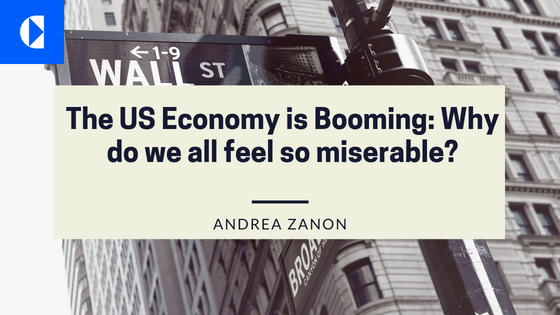The post pandemic recovery is taking a toll on people, and the lag time to adjust to the new economy is longer than expected
Based on 2023 and 2024 data, American should be celebrating the incredible resilience of their economy. Inflation is rapidly slowing, incomes are increasing particularly among poorer people, jobs are abundant, and Wall Street just hit new records.
The US economy grew at an annualized pace of 4.9% the final three months of 2023 according to the Bureau of Economic Analyses, (BEA) this is more than twice analyst expectations at the end of October 2023. This growth is supported by robust wage growth for low-income Americans which is why spending continues to be strong. For 2023 as a whole GDP growth was an impressive 2.5%. This is remarkable considering that most bankers, supported by President Trump expected America to in recession by now. To prove them wrong, the U.S. Economy added over 350,000 Jobs in January exceeding expectations. Finally, Wall Street has been on fire for most of 2023 closing the year with S&P 500 index of leading American stocks at a record high of 5000 points.
In terms of inflation, the personal consumption expenditure price index reached 2.6% in November 2023 compared with a year earlier, and down from 7% in mid-2022. The disinflation has been propelled by declines in goods prices and energy as supply chains have recovered from pandemic disruptions. Jerome Powell, the Fed’s chairman, seemed indicating that as the economy normalizes, rate cuts could be expected by the spring, boosting housing purchases across the country.
Why are American so pessimistic?
The figure watched most closely by economists for an idea of what people are feeling is a consumer-sentiment index from the University of Michigan. For the past two years it has bounced around at levels last seen during the global financial crisis of 2007-09. Even with an improvement in December, it is still 30% below its recent peak on the eve of the covid-19 crisis in early 2020.
After-tax personal income is about 15% lower now than in March 2021, when it was propped up by the massive stimulus package passed by Democrats soon after Mr Biden took office.
Another unflattering comparison with the recent past: the aggressive interest-rate rises needed to tame inflation has made loans for houses and cars much more expensive. Housing affordability hit its lowest in decades last year, serving as an easy target for critics of President Biden.
The conclusions by many economists is that Americans are being unreasonably pessimistic, and are still adjusting to the “new economic order” that is the result of the 2008 financial crisis and the more recent pandemic of 2020. As explained in the Economist, there may simply be a long lag between the post-pandemic recovery and feelings about the economy. Furthermore, the “power of bad” is President Trump preferred electoral campaign weapon, which he is using to scare people about the future of America.

